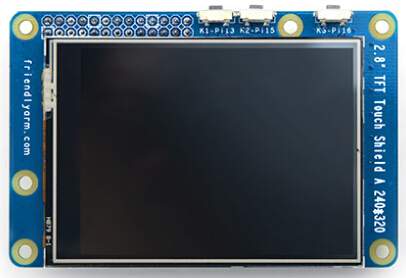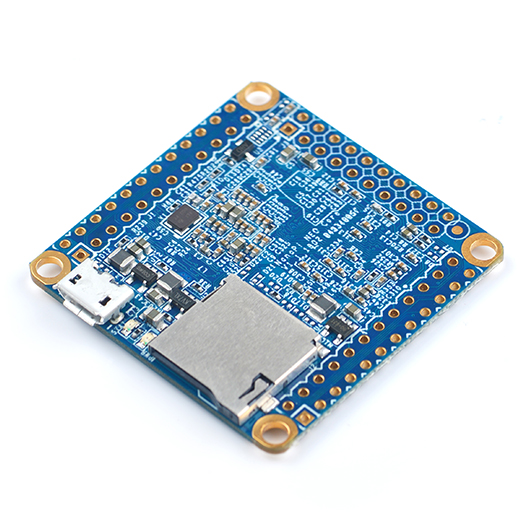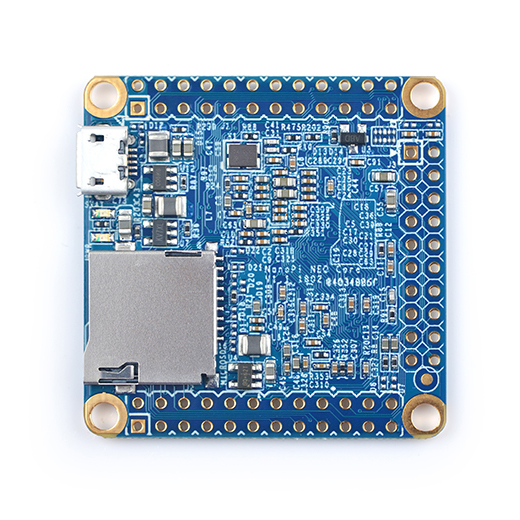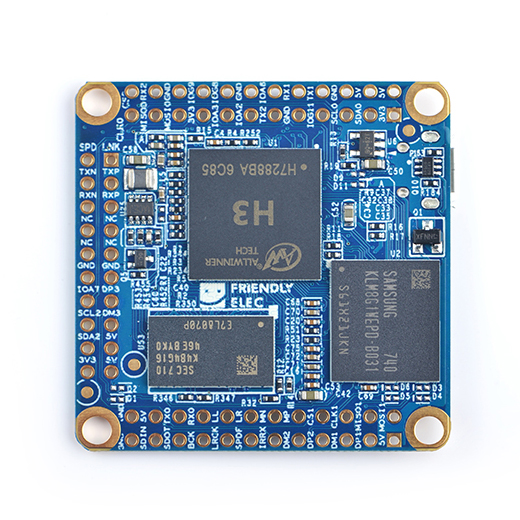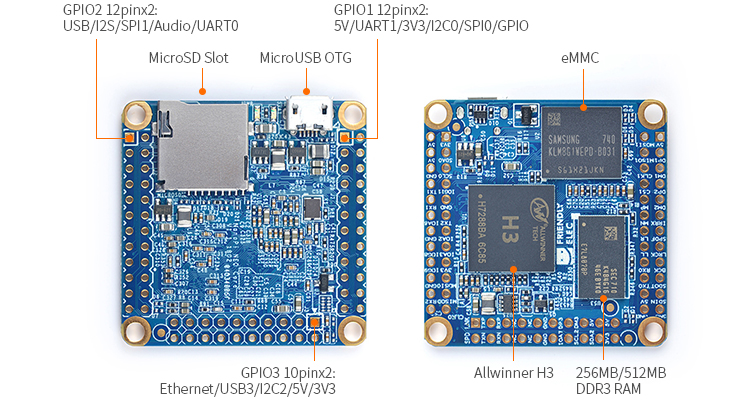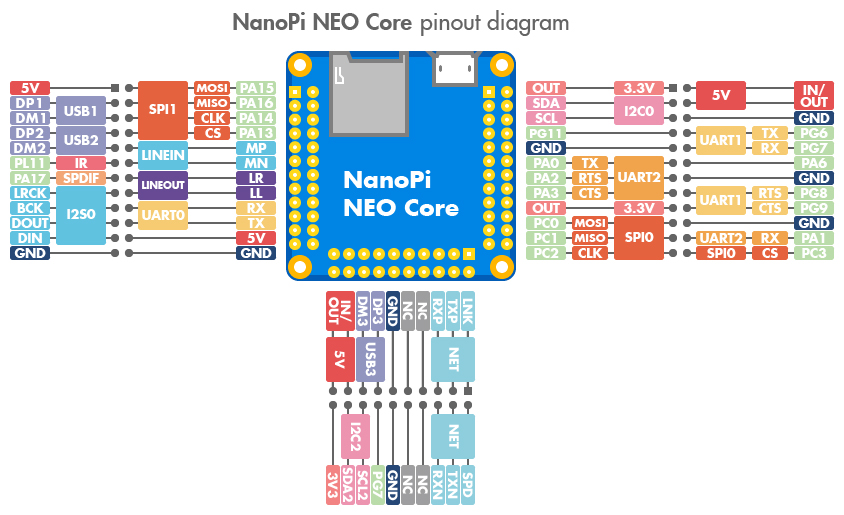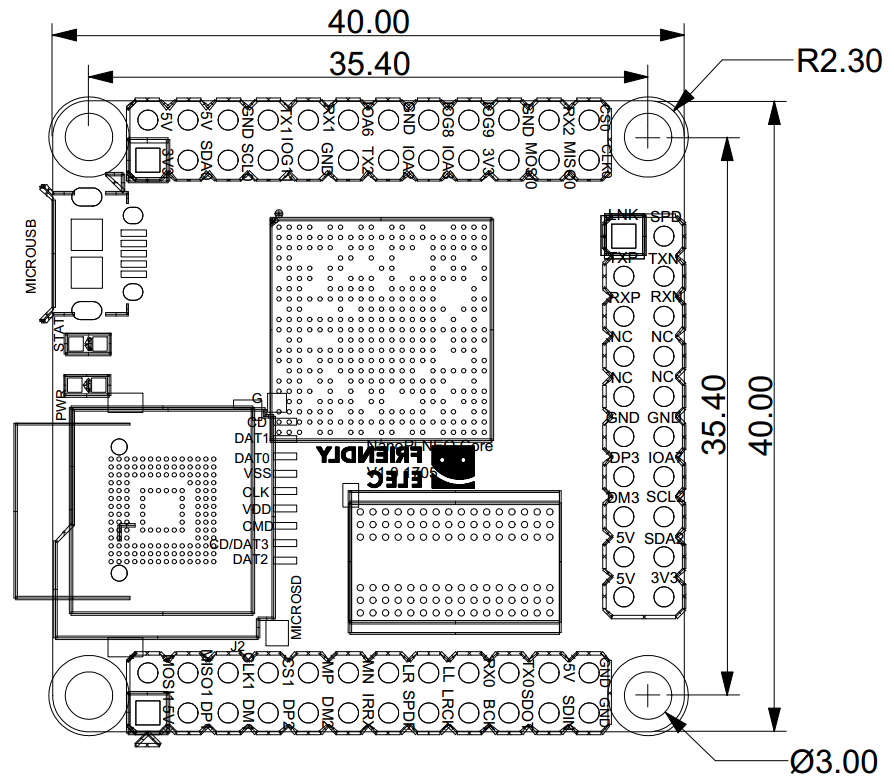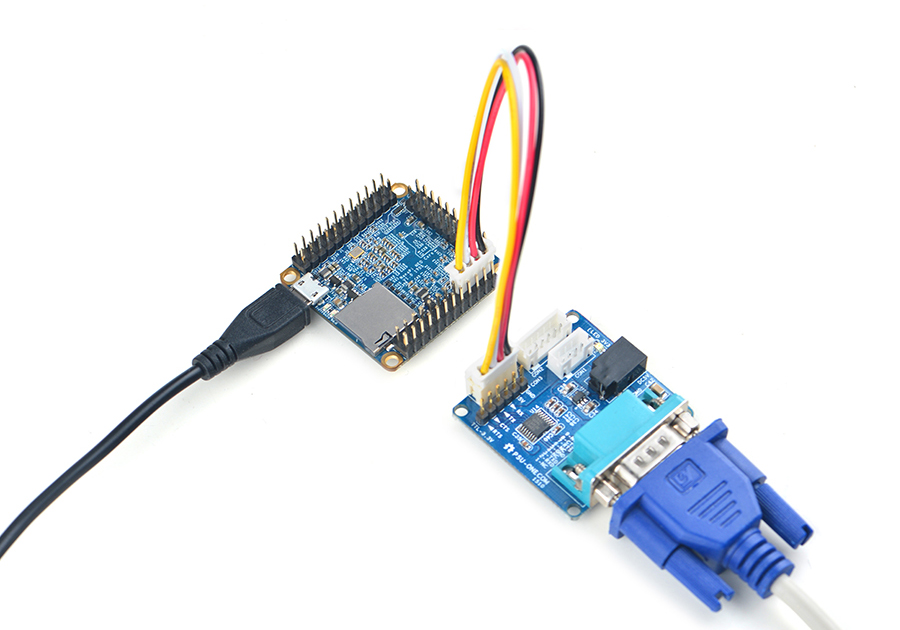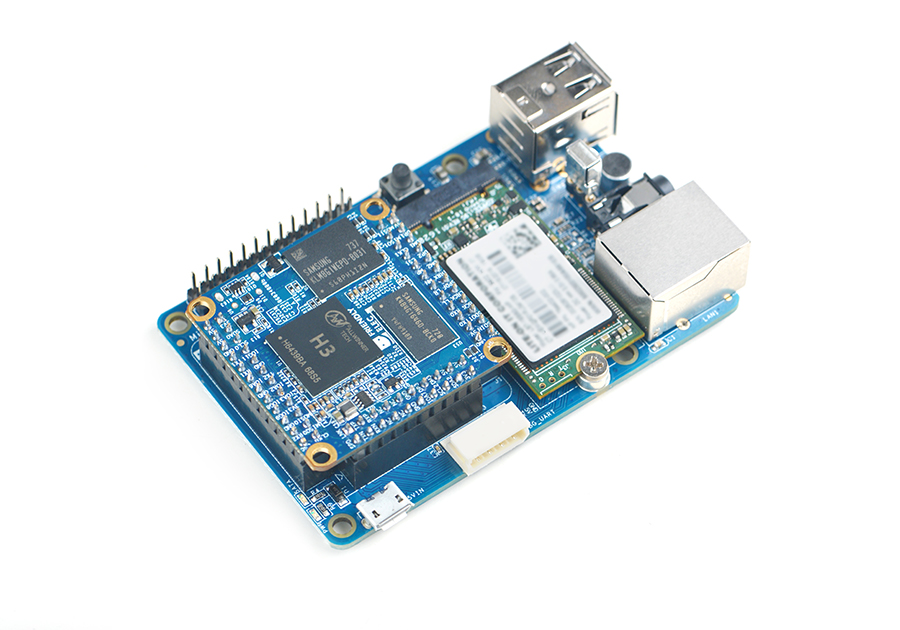Difference between revisions of "NanoPi NEO Core"
| Line 179: | Line 179: | ||
[[File:eflasher-console.jpg|frameless|600px|eflasher-console]]<br> | [[File:eflasher-console.jpg|frameless|600px|eflasher-console]]<br> | ||
After it is done power off the board and take out the TF card. Power on the board again and your board will boot from eMMC. | After it is done power off the board and take out the TF card. Power on the board again and your board will boot from eMMC. | ||
| − | |||
==Work with Ubuntu-Core with Qt-Embedded== | ==Work with Ubuntu-Core with Qt-Embedded== | ||
| Line 204: | Line 203: | ||
</syntaxhighlight> | </syntaxhighlight> | ||
| − | === | + | ===Extend NEO Core's TF Card Section=== |
| − | + | When Ubuntu is loaded the TF card's section will be automatically extended.You can check the section's size by running the following command: | |
<syntaxhighlight lang="bash"> | <syntaxhighlight lang="bash"> | ||
$ df -h | $ df -h | ||
</syntaxhighlight> | </syntaxhighlight> | ||
| − | === | + | ===Configure System with npi-config=== |
| − | npi- | + | The npi-config is a commandline utility which can be used to initialize system configurations such as user password, system language, time zone, Hostname, SSH switch , Auto login, hardware interface(Serial/I2C/SPI/PWM/I2S) and etc. Type the following command to run this utility. |
<syntaxhighlight lang="bash"> | <syntaxhighlight lang="bash"> | ||
$ sudo npi-config | $ sudo npi-config | ||
</syntaxhighlight> | </syntaxhighlight> | ||
| − | npi- | + | Here is how npi-config's GUI looks like:<br /> |
[[File:npi-config.jpg|frameless|500px|npi-config]]<br /> | [[File:npi-config.jpg|frameless|500px|npi-config]]<br /> | ||
| − | === | + | ===Ethernet Connection=== |
| − | NEO | + | If a NanoPi NEO Core is connected to a network via Ethernet before it is powered on it will automatically obtain an IP after it is powered up. If it is not connected via Ethernet or its DHCP is not activated obtaining an IP will fail and system will hang on for about 15 to 60 seconds. |
| − | + | In this case you can try obtaining an IP by using the following command | |
<syntaxhighlight lang="bash"> | <syntaxhighlight lang="bash"> | ||
| − | + | dhclient eth0 | |
</syntaxhighlight> | </syntaxhighlight> | ||
| − | === | + | ===Connect USB WiFi to NEO=== |
| − | + | Our system has support for popular USB WiFi drivers. Many USB WiFi modules are plug and play with our system. Here is a list of models we tested; | |
::{| class="wikitable" | ::{| class="wikitable" | ||
|- | |- | ||
| − | | | + | |Number || Model |
|- | |- | ||
|1 || RTL8188CUS/8188EU 802.11n WLAN Adapter | |1 || RTL8188CUS/8188EU 802.11n WLAN Adapter | ||
| Line 239: | Line 238: | ||
|4 || RTL8192CU Wireless Adapter | |4 || RTL8192CU Wireless Adapter | ||
|- | |- | ||
| − | |5 || | + | |5 || MI WiFi mt7601 |
|} | |} | ||
| − | * | + | If you NanoPi NEO Core is connected to a USB WiFi and is powered up you can log into NEO Core and run the following command to check if the USB WiFi is recognized. If "wlan0" is listed it indicates your USB WiFi has been recognized: |
| + | <syntaxhighlight lang="bash"> | ||
| + | $ sudo ifconfig -a | ||
| + | </syntaxhighlight> | ||
| + | You can use the NetworkManager utility in Ubuntu to manager its network. You can run "nmcli" in the commandline utility to start it. Here are the commands to start a WiFi connection: | ||
| + | * Check device list | ||
<syntaxhighlight lang="bash"> | <syntaxhighlight lang="bash"> | ||
$ sudo nmcli dev | $ sudo nmcli dev | ||
</syntaxhighlight> | </syntaxhighlight> | ||
| − | + | Note: if the status of a device is "unmanaged" it means that device cannot be accessed by NetworkManager. To make is accessed you need to clear the settings under "/etc/network/interfaces" and reboot your system. | |
| − | * | + | * Start WiFi |
<syntaxhighlight lang="bash"> | <syntaxhighlight lang="bash"> | ||
$ sudo nmcli r wifi on | $ sudo nmcli r wifi on | ||
</syntaxhighlight> | </syntaxhighlight> | ||
| − | * | + | * Scan Surrounding WiFi Sources |
<syntaxhighlight lang="bash"> | <syntaxhighlight lang="bash"> | ||
$ sudo nmcli dev wifi | $ sudo nmcli dev wifi | ||
</syntaxhighlight> | </syntaxhighlight> | ||
| − | * | + | * Connect to a WiFi Source |
<syntaxhighlight lang="bash"> | <syntaxhighlight lang="bash"> | ||
$ sudo nmcli dev wifi connect "SSID" password "PASSWORD" | $ sudo nmcli dev wifi connect "SSID" password "PASSWORD" | ||
</syntaxhighlight> | </syntaxhighlight> | ||
| − | + | The "SSID" and "PASSWORD" need to be replaced with your actual SSID and password.If you have multiple WiFi devices you need to specify the one you want to connect to a WiFi source with iface<br /> | |
| − | + | If a connection succeeds it will be automatically setup on next system reboot.<br /> | |
<br /> | <br /> | ||
| − | + | For more details about NetworkManager refer to this link: [[Use NetworkManager to configure network settings]]<br /> | |
| − | === | + | ===Login via SSH=== |
| − | NEO | + | The NanoPi NEO Core doesn't have a video output interface. You can log into the board via SSH. In our test the IP address detected by our router was 192.168.1.230 and we ran the following command to log into the NanoPi NEO Core: |
<syntaxhighlight lang="bash"> | <syntaxhighlight lang="bash"> | ||
$ ssh root@192.168.1.230 | $ ssh root@192.168.1.230 | ||
</syntaxhighlight> | </syntaxhighlight> | ||
| − | + | The password is fa | |
| − | === | + | ===Connect NanoPi NEO Core to USB Camera(FA-CAM202)=== |
[[File:USB-Camera-NanoPi-neo-core.png|frameless|500px|USB camera]]<br/> | [[File:USB-Camera-NanoPi-neo-core.png|frameless|500px|USB camera]]<br/> | ||
| − | + | The FA-CAM202 is a 2M-pixel USB camera module. | |
| − | + | Boot your NEO Core, connect NEO Core to the internet, log in the system as root, compile and run the mjpg-streamer utility: | |
<syntaxhighlight lang="bash"> | <syntaxhighlight lang="bash"> | ||
$ su root | $ su root | ||
| Line 283: | Line 287: | ||
$ ./start.sh | $ ./start.sh | ||
</syntaxhighlight> | </syntaxhighlight> | ||
| − | mjpg- | + | The mjpg-streamer is an open source media server. After it is started successfully you will see the following messages: |
<syntaxhighlight lang="bash"> | <syntaxhighlight lang="bash"> | ||
i: Using V4L2 device.: /dev/video0 | i: Using V4L2 device.: /dev/video0 | ||
| Line 296: | Line 300: | ||
</syntaxhighlight> | </syntaxhighlight> | ||
| − | + | In our case our NEO Core's IP address was 192.168.1.123. We typed "192.168.1.123:8080" on a browser, entered and we got the following screenshot:<br> | |
[[File:mjpg-streamer-cam500a.png|frameless|600px|mjpg-streamer-cam500a]] <br> | [[File:mjpg-streamer-cam500a.png|frameless|600px|mjpg-streamer-cam500a]] <br> | ||
| − | === | + | ===Check CPU's Working Temperature=== |
| − | + | Open a terminal on your NanoPi NEO Core and you can type the following command to read H3's temperature and frequency: | |
<syntaxhighlight lang="bash"> | <syntaxhighlight lang="bash"> | ||
$ cpu_freq | $ cpu_freq | ||
</syntaxhighlight> | </syntaxhighlight> | ||
| − | === | + | ===Check System Information with Rpi-Monitor=== |
| − | Ubuntu- | + | Our Ubuntu-Core contains the Rpi-Monitor utility with which users can check system information and status.<br> |
| − | + | In our case our NEO Core's IP was 192.168.1.230 and we typed the following IP in a browser: | |
<syntaxhighlight lang="bash"> | <syntaxhighlight lang="bash"> | ||
192.168.1.230:8888 | 192.168.1.230:8888 | ||
</syntaxhighlight> | </syntaxhighlight> | ||
| − | + | We entered the following page:<br> | |
[[File:rpi-monitor.png|frameless|700px|rpi-monitor]] <br> | [[File:rpi-monitor.png|frameless|700px|rpi-monitor]] <br> | ||
| − | + | Users can easily check these system information and status. | |
| − | === | + | ===Access GPIO Pins/Wirings with WiringNP=== |
| − | + | The wiringPi library was initially developed by Gordon Henderson in C. It contains libraries to access GPIO, I2C, SPI, UART, PWM and etc. | |
| − | + | The wiringPi library contains various libraries, header files and a commandline utility:gpio. The gpio utility can be used to read and write GPIO pins.<br> | |
| − | + | FriendlyElec integrated this utility in NEO Core's system allowing users to easily access GPIO pins. For more details refer to [[WiringNP:_WiringPi_for_NanoPi_NEO/NEO2|WiringNP]] | |
==如何编译Ubuntu-Core with Qt-Embedded系统== | ==如何编译Ubuntu-Core with Qt-Embedded系统== | ||
Revision as of 09:46, 1 December 2017
Contents
- 1 Introduction
- 2 Hardware Spec
- 3 Diagram, Layout and Dimension
- 4 Get Started
- 5 Work with Ubuntu-Core with Qt-Embedded
- 5.1 Run Ubuntu-Core with Qt-Embedded
- 5.2 Extend NEO Core's TF Card Section
- 5.3 Configure System with npi-config
- 5.4 Ethernet Connection
- 5.5 Connect USB WiFi to NEO
- 5.6 Login via SSH
- 5.7 Connect NanoPi NEO Core to USB Camera(FA-CAM202)
- 5.8 Check CPU's Working Temperature
- 5.9 Check System Information with Rpi-Monitor
- 5.10 Access GPIO Pins/Wirings with WiringNP
- 6 如何编译Ubuntu-Core with Qt-Embedded系统
- 7 使用扩展配件及编程示例
- 8 3D 打印外壳
- 9 资源链接
1 Introduction
- The NanoPi NEO Core(abbreviated as "NEO Core") is an alternative NanoPi NEO that works like a CPU board with male pin-headers. It has the same form factor as the NanoPi NEO and same pin descriptions. The connectors and ports are populated to pin-headers on the NEO Core. In addition the NEO Core can have an optional onboard eMMC flash which is preferred by industrial customers.
- The NEO Core uses a popular Allwinner H3 SoC and has onboard 256M/512M DDR3 RAM. FriendlyElec offers models with three eMMC options: 8GB/16GB/32GB and one that doesn't have eMMC at all.
- FriendlyElec migrated UbuntuCore with mainline kernel 4.11 for it.
- FriendlyElec develops a Mini Shield for NanoPi NEO Core/Core2 which has the same form factor as the RPi 3. When a NanoPi NEO Core is connected to this Mini Shield the whole assembled module can be well fit into a common RPi 3's case.
2 Hardware Spec
- CPU: Allwinner H3, Quad-core Cortex-A7 Up to 1.2GHz
- DDR3 RAM: 256MB/512MB DDR3 RAM
- Storage: NC/8GB/16GB/32GB eMMC
- MicroSD Slot x 1
- MicroUSB: OTG and power input
- GPIO: two 2.54mm spacing 12x2pin header,one 2.54mm spacing 10x2pin header
- Connectivity: 10/100M Ethernet(6Pin, included in 2.54mm pitch pin header)
- USB Host x3(included in 2.54mm pitch pin header)
- Debug Serial Port(4Pin, included in 2.54mm pitch pin header )
- Audio input/output Port(4Pin, included in 2.54mm pitch pin header )
- GPIO:It includes UART, SPI, I2C, IO etc
- PC Size: 40 x 40mm
- Power Supply: DC 5V/2A
- Temperature measuring range: -40℃ to 80℃
- OS/Software: U-boot,Ubuntu-Core
- Weight: xxg(WITHOUT Pin-headers)
3 Diagram, Layout and Dimension
3.1 Layout
- GPIO1 Pin Description
Pin# Name Linux gpio Pin# Name Linux gpio 1 SYS_3.3V 2 VDD_5V 3 I2C0_SDA / GPIOA12 4 VDD_5V 5 I2C0_SCL / GPIOA11 6 GND 7 GPIOG11 203 8 UART1_TX / GPIOG6 198 9 GND 10 UART1_RX / GPIOG7 199 11 UART2_TX / GPIOA0 0 12 GPIOA6 6 13 UART2_RTS / GPIOA2 2 14 GND 15 UART2_CTS / GPIOA3 3 16 UART1_RTS / GPIOG8 200 17 SYS_3.3V 18 UART1_CTS / GPIOG9 201 19 SPI0_MOSI / GPIOC0 64 20 GND 21 SPI0_MISO / GPIOC1 65 22 UART2_RX / GPIOA1 1 23 SPI0_CLK / GPIOC2 66 24 SPI0_CS / GPIOC3 67
- GPIO2 Pin Description
Pin# Name Linux gpio Pin# Name Linux gpio 1 VDD_5V 2 SPI1_MOSI / GPIOA15 15 3 USB-DP1 4 SPI1_MISO / GPIOA16 16 5 USB-DM1 6 SPI1_CLK / GPIOA14 14 7 USB-DP2 8 SPI1_CS / GPIOA13 13 9 USB-DM2 10 MICIN1P 11 GPIOL11/IR-RX 363 12 MICIN1N 13 SPDIF-OUT/GPIOA17 17 14 LINEOUTR 15 PCM0_SYNC/I2S0_LRCK/I2C1_SCL 16 LINEOUTL 17 PCM0_CLK/I2S0_BCK/I2C1_SDA 18 UART_RXD0 / GPIOA5 / PWM0 5 19 PCM0_DOUT/I2S0_SDOUT 20 UART_TXD0 / GPIOA4 4 21 PCM0_DIN/I2S0_SDIN 22 VDD_5V 23 GND 24 GND
- GPIO3 Pin Description
Pin# Name Linux gpio Pin# Name Linux gpio 1 EPHY-LINK-LED 2 EPHY-SPD-LED 3 EPHY-TXP 4 EPHY-TXN 5 EPHY-RXP 6 EPHY-RXN 7 NC 8 NC 9 NC 10 NC 11 GND 12 GND 13 USB-DP3 14 GPIOA7 7 15 USB-DM3 16 I2C2_SCL / GPIOE12 17 5V 18 I2C2_SDA / GPIOE13 19 5V 20 SYS_3.3V
- Note:
- SYS_3.3V: 3.3V power output
- VVDD_5V: 5V power input/output. When the external device’s power is greater than the MicroUSB's the external device is charging the board otherwise the board powers the external device. The input range is 4.7V ~ 5.6V
- All pins are 3.3V, output current is 5mA
- For more details refer to its schematic
3.2 Dimensional Diagram
- For more details refer to the document: pcb in dxf format
- For more details refer to the document: pcb in dxf format
4 Get Started
4.1 Essentials You Need
Before starting to use your NanoPi NEO Core get the following items ready
- NanoPi NEO Core
- microSD Card/TF Card: Class 10 or Above, minimum 8GB SDHC
- microUSB power. A 5V/2A power is a must
- A Host computer running Ubuntu 14.04 64 bit system
4.2 TF Cards We Tested
To make your NanoPi NEO Core boot and run fast we highly recommend you use a Class10 8GB SDHC TF card or a better one. The following cards are what we used in all our test cases presented here:
- SanDisk TF 8G Class10 Micro/SD TF card:
- SanDisk TF128G MicroSDXC TF 128G Class10 48MB/S:
- 川宇 8G C10 High Speed class10 micro SD card:
4.3 Make an Installation TF Card
4.3.1 Get Image Files
Visit this link download link to download image files and the flashing utility:
Image Files: nanopi-neo-core_ubuntu-core-xenial_4.x.y_YYYYMMDD.img.zip Ubuntu-Core with Qt-Embedded Image File, Kernel: Linux-4.x.y nanopi-neo-core_eflasher_4.x.y_YYYYMMDD.img.zip eflasher Image File, Kernel: Linux-4.x.y Flash Utility: win32diskimager.rar Windows utility for flashing Debian image. Under Linux users can use "dd"
4.3.2 Make Bootable TF Card
4.3.2.1 Make UbuntuCore with Qt Embedded Image Card
- Extract the image file and win32diskimager.rar files. Insert a TF card(at least 8G) into a Windows PC and run the win32diskimager utility as administrator. On the utility's main window select your TF card's drive, the wanted image file and click on "write" to start flashing the TF card.
- After flashing is done insert this TF card to your NanoPi NEO Core and connect the board to a 5V/2A power NEO Core will be automatically powered on. If the green LED is solid on and the blue LED is flashing it indicates the system is being booted.
Note: this method applies to making a bootable TF card with Debian too.
4.3.3 Flash OS to eMMC
- Extract the image file and win32diskimager.rar files. Insert a TF card(at least 8G) into a Windows PC and run the win32diskimager utility as administrator. On the utility's main window select your TF card's drive, the wanted image file and click on "write" to start flashing the TF card.
- After flashing is done insert this TF card to your NanoPi NEO Core and connect the board to a 5V/2A power NEO Core will be automatically powered on. If the green LED is solid on and the blue LED is flashing it indicates the system is being booted.
- Run the following commands in a terminal to flash OS to eMMC:
$ su root
$ eflasherThe password for "root" is "fa". Type a number and press "enter" to select an OS you want to flash and then type "yes" and press "enter" to start flashing:

After it is done power off the board and take out the TF card. Power on the board again and your board will boot from eMMC.
5 Work with Ubuntu-Core with Qt-Embedded
5.1 Run Ubuntu-Core with Qt-Embedded
- If you want to do kernel development you need to use a serial communication board, ie a PSU-ONECOM board, which will allow you to operate the board via a serial terminal.
- Here is a setup where we connect a NanoPi NEO Core to a Mini Shield for NanoPi NEO Core/Core2. Here is an introduction to Mini Shield for NanoPi NEO Core/Core2 Mini Shield
:
- Ubuntu-Core's User Accounts:
Non-root User:
User Name: pi Password: pi
root:
User Name: root Password: fa
neo-core-login
The system is automatically logged in as "pi". You can do "sudo npi-config" to disable auto login.
- Update packages
$ sudo apt-get update
5.2 Extend NEO Core's TF Card Section
When Ubuntu is loaded the TF card's section will be automatically extended.You can check the section's size by running the following command:
$ df -h
5.3 Configure System with npi-config
The npi-config is a commandline utility which can be used to initialize system configurations such as user password, system language, time zone, Hostname, SSH switch , Auto login, hardware interface(Serial/I2C/SPI/PWM/I2S) and etc. Type the following command to run this utility.
$ sudo npi-config
Here is how npi-config's GUI looks like:

5.4 Ethernet Connection
If a NanoPi NEO Core is connected to a network via Ethernet before it is powered on it will automatically obtain an IP after it is powered up. If it is not connected via Ethernet or its DHCP is not activated obtaining an IP will fail and system will hang on for about 15 to 60 seconds. In this case you can try obtaining an IP by using the following command
dhclient eth0
5.5 Connect USB WiFi to NEO
Our system has support for popular USB WiFi drivers. Many USB WiFi modules are plug and play with our system. Here is a list of models we tested;
Number Model 1 RTL8188CUS/8188EU 802.11n WLAN Adapter 2 RT2070 Wireless Adapter 3 RT2870/RT3070 Wireless Adapter 4 RTL8192CU Wireless Adapter 5 MI WiFi mt7601
If you NanoPi NEO Core is connected to a USB WiFi and is powered up you can log into NEO Core and run the following command to check if the USB WiFi is recognized. If "wlan0" is listed it indicates your USB WiFi has been recognized:
$ sudo ifconfig -a
You can use the NetworkManager utility in Ubuntu to manager its network. You can run "nmcli" in the commandline utility to start it. Here are the commands to start a WiFi connection:
- Check device list
$ sudo nmcli dev
Note: if the status of a device is "unmanaged" it means that device cannot be accessed by NetworkManager. To make is accessed you need to clear the settings under "/etc/network/interfaces" and reboot your system.
- Start WiFi
$ sudo nmcli r wifi on
- Scan Surrounding WiFi Sources
$ sudo nmcli dev wifi
- Connect to a WiFi Source
$ sudo nmcli dev wifi connect "SSID" password "PASSWORD"
The "SSID" and "PASSWORD" need to be replaced with your actual SSID and password.If you have multiple WiFi devices you need to specify the one you want to connect to a WiFi source with iface
If a connection succeeds it will be automatically setup on next system reboot.
For more details about NetworkManager refer to this link: Use NetworkManager to configure network settings
5.6 Login via SSH
The NanoPi NEO Core doesn't have a video output interface. You can log into the board via SSH. In our test the IP address detected by our router was 192.168.1.230 and we ran the following command to log into the NanoPi NEO Core:
$ ssh root@192.168.1.230
The password is fa
5.7 Connect NanoPi NEO Core to USB Camera(FA-CAM202)
USB camera
The FA-CAM202 is a 2M-pixel USB camera module.
Boot your NEO Core, connect NEO Core to the internet, log in the system as root, compile and run the mjpg-streamer utility:
$ su root $ cd /root/mjpg-streamer $ make $ ./start.sh
The mjpg-streamer is an open source media server. After it is started successfully you will see the following messages:
i: Using V4L2 device.: /dev/video0 i: Desired Resolution: 1280 x 720 i: Frames Per Second.: 30 i: Format............: YUV i: JPEG Quality......: 90 o: www-folder-path...: ./www/ o: HTTP TCP port.....: 8080 o: username:password.: disabled o: commands..........: enabled
In our case our NEO Core's IP address was 192.168.1.123. We typed "192.168.1.123:8080" on a browser, entered and we got the following screenshot:

5.8 Check CPU's Working Temperature
Open a terminal on your NanoPi NEO Core and you can type the following command to read H3's temperature and frequency:
$ cpu_freq5.9 Check System Information with Rpi-Monitor
Our Ubuntu-Core contains the Rpi-Monitor utility with which users can check system information and status.
In our case our NEO Core's IP was 192.168.1.230 and we typed the following IP in a browser:
192.168.1.230:8888We entered the following page:
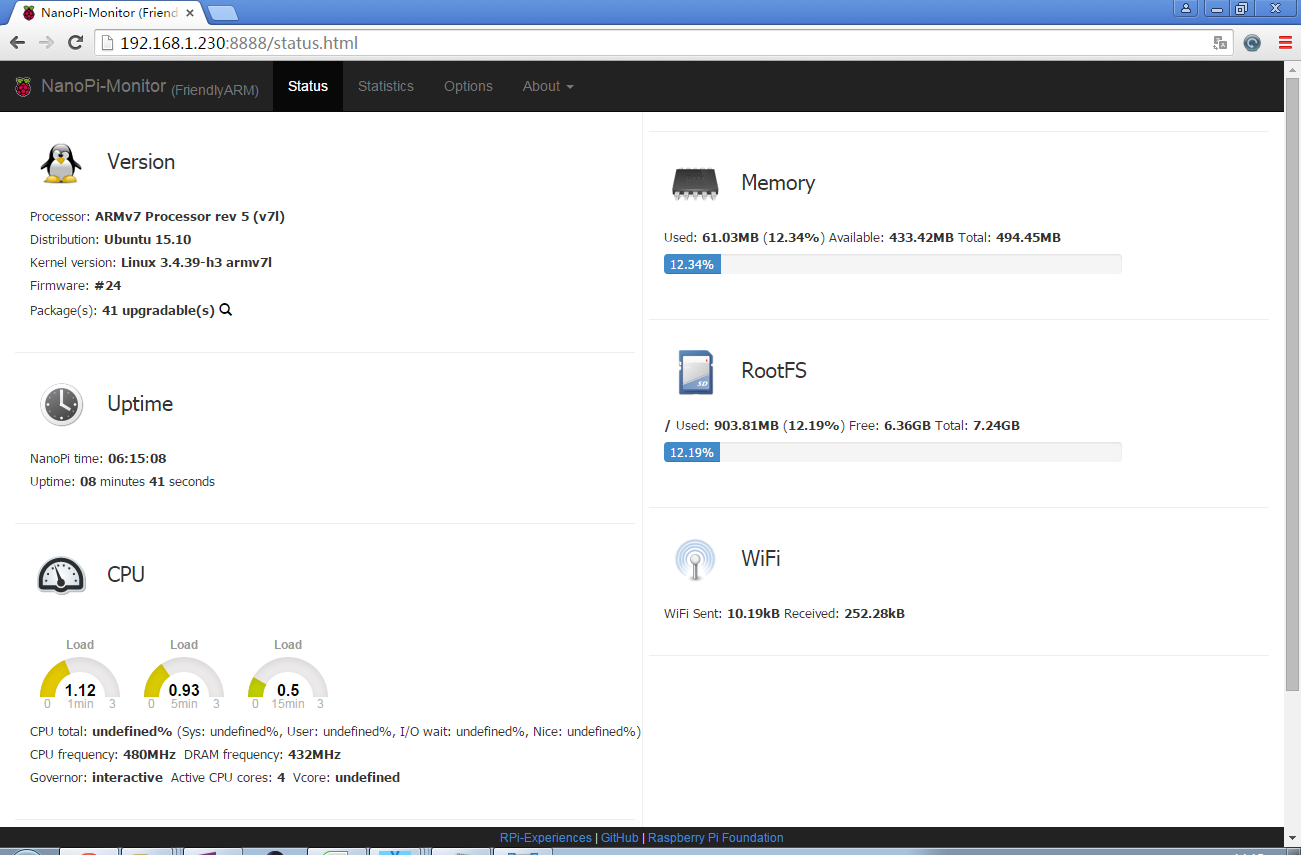
Users can easily check these system information and status.
5.10 Access GPIO Pins/Wirings with WiringNP
The wiringPi library was initially developed by Gordon Henderson in C. It contains libraries to access GPIO, I2C, SPI, UART, PWM and etc.
The wiringPi library contains various libraries, header files and a commandline utility:gpio. The gpio utility can be used to read and write GPIO pins.
FriendlyElec integrated this utility in NEO Core's system allowing users to easily access GPIO pins. For more details refer to WiringNP
6 如何编译Ubuntu-Core with Qt-Embedded系统
6.1 使用开源社区主线BSP
NEO Core现已支持使用Linux-4.x.y内核,并使用Ubuntu Core 16.04,关于H3芯片系列开发板使用主线U-boot和Linux-4.x.y的方法,请参考维基:Mainline U-boot & Linux
7 使用扩展配件及编程示例
7.1 使用Mini Shield for NanoPi NEO Core/Core2
7.2 使用Python编程操作NanoHat OLED扩展板
NanoHat OLED是一款精致小巧的单色OLED显示屏,带3个按键,我们不仅提供了源代码级驱动,而且为您展现了一个简单实用的Shell界面, 通过它你可以查看系统时间,系统运行状态,以及关机等操作;你还可以下载所有源代码自行修改编译,设计自己喜欢的界面; 配上我们专门为其定制的全金属铝外壳,相信你一定会爱不释手!详见:NanoHat OLED
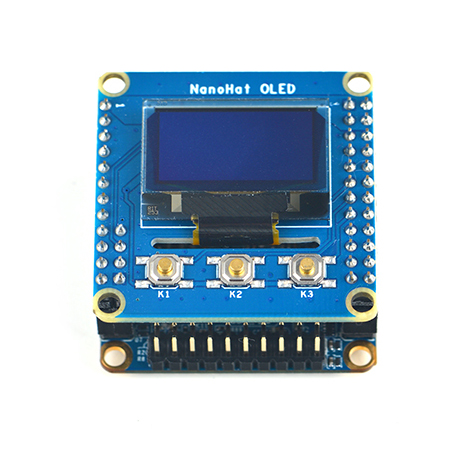
7.3 使用Python编程控制NanoHat Motor 电机驱动模块
该模块可驱动四个5V PWM舵机模块和四个12V直流电机或者两个12V四线步进电机,详见:NanoHat Motor
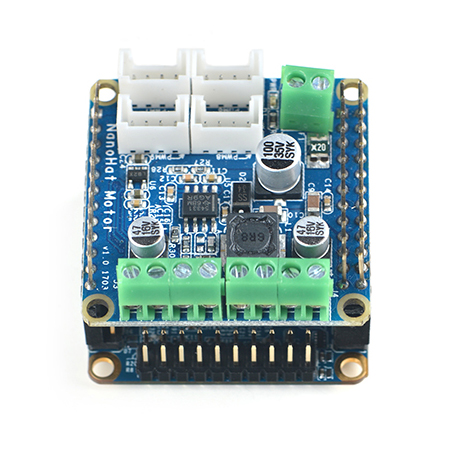
7.4 使用NanoHat PCM5102A 数字音频解码模块
NanoHat PCM5102A采用了TI公司专业的立体声DAC音频芯片PCM5102A,为您提供数字音频信号完美还原的音乐盛宴, 详见:NanoHat PCM5102A
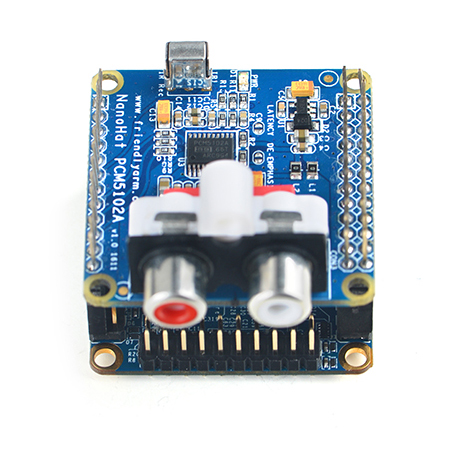
7.5 完全兼容的Arduino的UNO Dock扩展板
UNO Dock本身就是一个Arduino UNO,你可以使用Arduino IDE开发下载运行所有Arduino工程项目;它还是NanoPi NEO的扩展坞,不仅为其提供稳定可靠的电源输入,还可以使用Python编程控制Arduino配件,借助强大的Ubuntu生态系统,快速把你的Arduino项目送上云端,详见:UNO Dock for NanoPi NEO v1.0
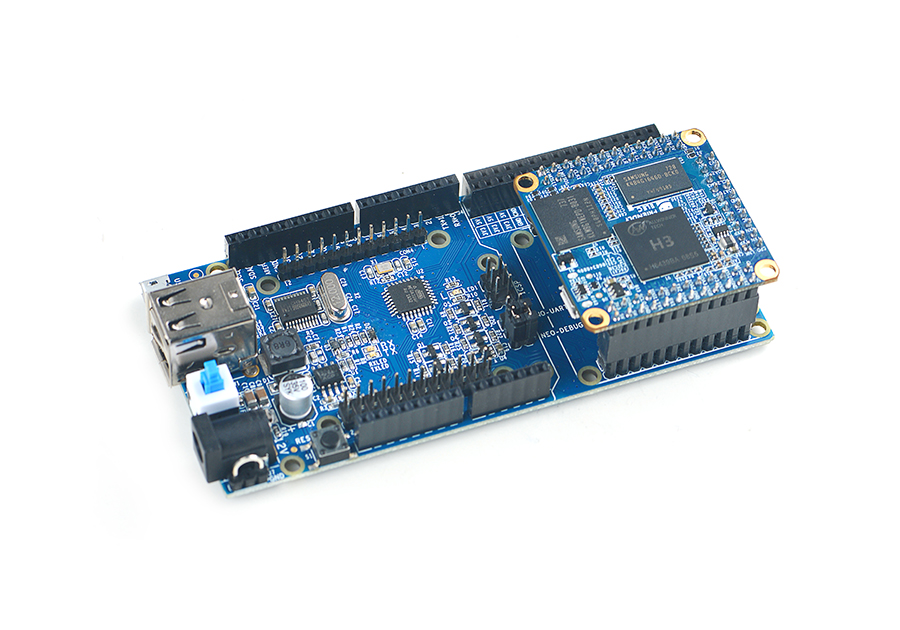
7.6 Power Dock 高效的电源转换模块
Power Dock for NanoPi NEO是一个高效的电源转换模块,能为用电设备提供稳定可靠的供电, 详见:Power Dock for NanoPi NEO
Power Dock for NanoPi NEO_nanopi_NEO_Core
7.7 NanoHat Proto 可堆叠的面包板模块
NanoHat Proto是一个功能高度自由的模块, 板载EEPROM,详见:NanoHat Proto
Matrix - NanoHat Proto_nanopi_NEO_Core
7.8 Matrix - 2'8 SPI Key TFT显示模块
Matrix-2'8_SPI_Key_TFT模块是一款2.8英寸的TFT 触摸LCD,模块采用ST7789S驱动IC和XPT2046电阻式触摸IC,屏幕分辨率为240*320,采用SPI控制接口,模块还包含3个独立按键,可根据需要自定义功能。详见:Matrix - 2'8 SPI Key TFT
